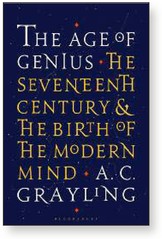
Bloomsbury New York. 2016. 368 pp. $30.00 ISBN-13: 978-1620403440
WESTERN CIVILIZATION MAY BE DEFINED by the central place that the scientific method occupies in the intellectual fields, and by its democratic institutions. These features of the West may be traced back to England in 1687 when Isaac Newton published the Principia Mathematica, and 1688, when England’s parliament seized control of England’s government with a little help from the Dutch king and queen, William and Mary. These two events, one magnificent and the other glorious, redefined Western civilization. Newton gave the world physical laws and England’s parliament gave its citizens basic freedoms. A line can be drawn from our modern institutions to these two events and the fact that they both occurred in the same place at the same time has drawn the attention of many scholars including England’s eminent philosopher, A.C. Grayling. In his new book, The Age ofGenius: The Seventeenth Century and the Birth of the Modern Mind, Grayling argues that the earthquakes of destruction that occurred in the 17th century—the Thirty Years War, the ongoing Protestant Reformation, the English Civil War, and the Anglo-Dutch Wars—tilled the ground for the growth of new ideas. These included the concept of the individual, the spread of literacy and printing, and the notion of scientific evidence as the factor that decided truth.
Grayling’s argument is holistic. Early in the book, he writes “…seeing the pattern in a major movement of thought is like taking an aerial view of a landscape: one seeks out the larger contours, and because in explaining the seventeenth century the principal themes are science, philosophy, and ideas, it is an arena where the philosopher and historian of ideas venture with propriety” (3-4). Later, he addresses the principal question of the era by writing “It is or should be a puzzle that this explosion of genius occurred in a century so tumultuous—a time of wars, civil strife, and the continuation of post-Reformation religious agonies disruptive and destructive to an unparalleled degree in Europe’s history to that point. How does one account for the flowering of genius in the midst of such conflict?” (11). This is the right question. The reaper’s dual-edged scythe, with politics on one side and religion on the other, swept back and forth across Europe during the entire course of the 17th century. And if the Renaissance was a rebirth of classical ideas and art from Greece and Rome, then the Thirty Years War (1618-1648) in Germany was the rebirth of medievalism; forms of creativity that had once been reserved for the arts now manifested themselves in novel forms of torture and butchery. While the mercenaries in Germany rampaged, the parliamentarians in England rebelled, and just as the German princes committed to peace in 1648, the parliamentarians were committing regicide in 1649. As a result of the ensuing fighting, Grayling says, one-third of all people who spoke German died.